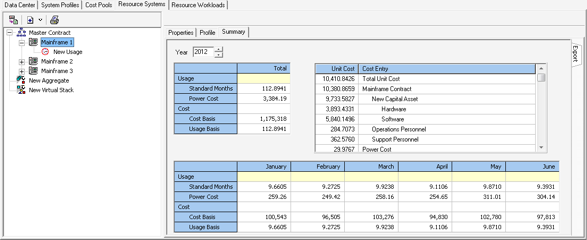


The Resource Catalog is the basis of all processing in RG Solutions®. It defines the resources to be
measured, the characteristics of the resources, the various costs associated with IT operations, and
the linking of these costs to the resources.
|
|
Major Data Features |
|
Data Center
|
This represents the actual data center that houses the system processing for the
IT services. It has properties that define the environmental attributes of the actual
data center such as electrical rates, power costs, and other considerations.
Resource Systems can be linked to the Data Center to allow for the use of rates
and costs as needed.
|
Cost Pools
|
These are dynamic in nature and allows for a structured approach to the formation
of the unit costs. The entries can represent either a Capital Asset or Expense type
entry. Each entry is based on a date range that defines the life of the cost, and
these dates are used by the processing to determine the unit costs for a particular
date. Cost Pools can be associated with a Resource System or Workload.
|
Resource
Systems
|
These are the catalog representation of a single physical system such as a
mainframe or standalone server. These resources have different processing
characteristics such as processor speed, system architecture, processing behavior,
and the types and numbers of applications processing on it. The costs associated
with these resources are generally those cost associated with the actual system.
|
Resource
Workloads
|
These are the unique applications (i.e. Oracle, Exchange, etc.) that are running on
one or more System Resources. The costs associated with these are generally
those costs of a particular application (i.e. software acquisition, training, support,
etc). Similar workloads can be grouped together for cost sharing.
|
Major Processing Capabilities
|
|
Power Rating
|
The processing incorporates the use of a normalized power rating. This value is
determined for each system within the catalog and provides for a consistent
metering framework that allows comparison and portability within the processing
environment.
|
Usage Basis
|
The catalog processing determines the underlying usage basis for each resource.
This value is used to determine the unit costs and can be automatically calculated
(through a forecast) or can be set by the user.
|
Cost Basis
|
The catalog processing determines the underlying cost basis for each resource
within the catalog. This value is based on the type of resource, the date of the
processing, and the costs linked to the particular resource.
|
Unit Prices
|
The Unit Prices are those values that are applied to the usage to form the
associated costs. Unit prices can be dynamically calculated using Cost Pools, or
can be manually set (the defaults) for a particular Data Center. Unit Costs can be
set for hardware and software processing, disk activity, and network activity.
|
Quotas
|
These are associated with metering and are used to define the limits of metered
processing. For default forecasting, the quota values will be automatically
determined. For contract metering, the quotas can be used to define the
processing constraints within the contract.
|
Forecasting
|
The processing provides the ability to determine future usage based on current
performance data, power ratings, and user provided growth estimates. The result
is information that can be used by the product to perform its calculations within a
metering framework, and these values can also be used for Capacity Planning.
|